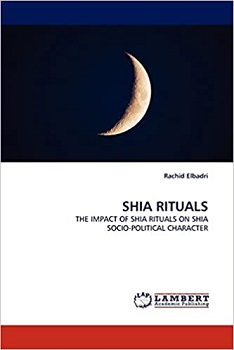Shia rituals the impact of Shia rituals on Shia socio-political character
 | |
| Author | Rachid Elbadri |
|---|---|
| Language | English |
| Published | 2010 |
| Publisher | LAP LAMBERT Academic Publishing |
| Pages | 108 |
The book Shia rituals the impact of Shia rituals on Shia socio-political character probes into the historical evolution, in form and content, of Ashura Rituals and reveals the three major stages through which Ashura rituals have passed.
About the author[edit | edit source]
Rachid Elbadri has Master of Arts in Security Studies (Middle East, South Asia, Sub-Saharan Africa), NAVAL POSTGRADUATE SCHOOL. He serves as political and cultural advisor for the Coalition Provisional Authority (CPA), Iraq 2003-2004. He advised the CO of coalition forces and the provincial acting governor in Maysan province, Iraq.
About the book[edit | edit source]
This book published in LAP LAMBERT Academic Publishing (July 26, 2010), has 108 pages and reveals how Ashura rituals are constructed, embraced, and evolved as well as how they are shaping Shia identity and communal sense. It helps the reader to understand the complexities of Shia rituals.
Abstract of chapters[edit | edit source]
Chapter I. INTRODUCTION[edit | edit source]
In this section, the author states the purpose of writing this book and discusses the importance of the subject and the framework of the work.
Chapter II. HISTORICAL BACKGROUND[edit | edit source]
This chapter provides description of the schism between Shia and Sunni with particular emphasis on the political and legal systems, ritual practices, and theological doctrines with the purpose of touching on the main contentious points while focusing on the political and legal systems, ritual practices, and theological doctrines. The author in this chapter depicts the battle of Karbala from the historical and spiritual perspectives as seen by Shia historians and Shia piety.
Chapter III. ASHURA RITUAL DESCRIPTIONS [edit | edit source]
In this chapter, the author describes the five major Ashura rituals practiced among world Shia communities including the memorial services (majalis al-ta’ziya), the visitation of Hussein’s tomb in Karbala particularly on the occasion of the 10th day of the month of Muharram and the 40th day after the battle (ziyarat Ashura and ziyarat arba‘in), the public mourning processions (al-mawakib al-husayniyya), the representation of the battle of Karbala in the form of a play (tashabih), and the self-flagellations (zangeel and tatbir), to show the different forms of rituals. He proves that these obviously differences are based among different ethnic groups, different social groups, different communities, and even within the same communities. These difference, however, are superficial and do not change the form of ritual described above.
Chapter IV. HISTORICAL EVOLUTION OF ASHURA RITUALS [edit | edit source]
Research has shown that, the Ashura rituals have evolved and passed through three major stages until they reached the present form and content in which they are held today. The first stage began shortly after the Battle of Karbala in year 680 AD, and it continued until the fall of Baghdad at the hands of Hulagu. The second stage began at the fall of Baghdad and continued through the Muslim dark ages until the modern period. The third and final stage was from the beginnings of the modern period until the present. In this chapter, the author tries to show how Umayyad, Abbasid, Buyids, Fatmids, Safavid, and Qajar influenced these three major stages.
Chapter V. RITUAL THEORY AND SHIA COMMUNAL IDENTITY[edit | edit source]
In this chapter the author tries to show the importance of Ashura rituals in group cohesion and solidarity by explaining how Ashura rituals are constructed, embraced, and evolved as well as how they are used by Shia as a way to reunite and to reconfirm common values shared between members of Shia societies. He believes that Ashura rituals are used by Shia as a way to reunite and reconfirm common values shared between members of Shia societies.
Chapter VI. CURRENT KARBALA NARRATIVE AND POLITICAL IMPLICATION[edit | edit source]
This chapter focuses on the third stage of the rites of remembrance. It shows their development and political implications. The author discusses the Shia leaders who were instrumental in shifting the meanings of Ashura from the soteriological to the revolutionary meanings. He shows how they have operationalized such meanings, and how the new meaning of the Karbala narrative has affected the practice of Ashura rituals in Iran and Lebanon in form and content will be analyzed.